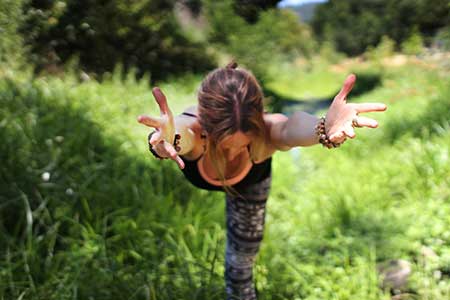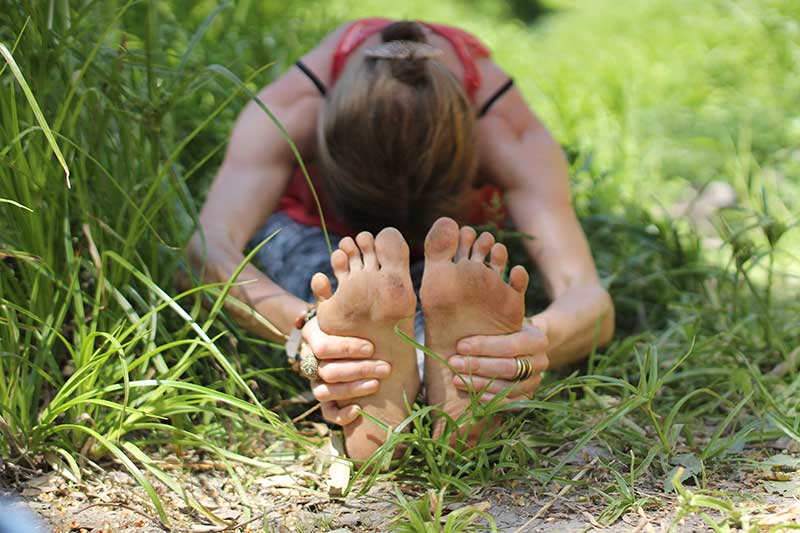
Have you ever suffered from anxiety or panic attacks? Perhaps before a competition or race, giving a presentation, teaching a class, taking an exam, or maybe even meeting a new person or date? We all have times in our life when we may feel some anxiety or nervousness. This can often feel uncomfortable and even frustrating because we lose our sense of control and presence, and it can be challenging to function normally when these anxious feelings arise.
I suffered from some social anxiety as a child and during my early teenage years. The anxiety manifested itself in different ways even into my mid to late 20s when I was working in the competitiveness corporate world in NYC, and training and racing in the competitive triathlon world all over the country. In the office, I would often feel incredibly thirsty, short of breath, and had bouts of sudden fatigue and weakness. I truly thought at the time that I had some medical condition or was sick. I had no idea these physical symptons were severe anxiety and stress. I was even taken to the emergency room once. My anxiety often took over my whole body and it truly felt like it was outside of my control.
In 2010 during my yoga teacher training, I learned and practiced various yoga breathing techniques called pranayama. Some of these breathing techniques felt a little strange at first, although after practicing them for a few days, I began to notice some shifts in my levels of overall nervousness and anxiety, and in my emotions as a whole. My anxiety was beginning to reduce and I felt lighter in my body and calmer in my mind. This was a big ah-ha moment for me as I realized that I was in fact in control of my physical symptoms and my anxiety. I learned that practicing these breathing techniques as a daily practice, before the anxiety arose was important. So I starting to integrate these pranayama techniques into my daily morning practice.
I'm sharing with you here 3 of my favorite pranayama techniques that have helped me. I also teach these techniques during our Body Flows yoga retreats.
Dirgha Pranayama is a deeply calming breath that slows down the breathing process. It increases the amount of carbon dioxide in the bloodstream so that the body learns to function more efficiently by using less oxygen. This breath uses the full capacity of the lungs, removing stale air and toxins and keeps the chest and lungs flexible and relaxed. We often find our energy levels increase after practicing Dirgha Pranayama. This happens because it is renewing the entire system, improving digestion and elimination as well.
Method: Lie down on your back. Take a deep inhale slowly and let the air travel all the way into the belly and into the bottom of the lungs. You can place one hand on your belly to feel the belly really expand. Then continue inhaling as you feel an expansion of the rib cage upwards and out to the sides. Continue inhaling and let the air travel up under the shoulders as it fills the lungs completely, even feeling the chest and upper back expand. You can place the other hand on your chest to feel this area expand under your hand. Then exhale slowly from the top to the bottom, letting the air release first from the chest then the rib cage then the belly last. Finally draw the belly back towards the spine gently as you engage the abdominal muscles at the end of the exhalation to squeeze out all of the residual air. Start by doing 3 full rounds, then take a break and come back to normal breath. If you feel good, do a few more rounds, and work your way up to doing 8-10 full rounds of inhale/exhale. Then rest.

The Nadis are pathways or channels of life force energy or prana through the body. They are similar to the veins and arteries in the physical body that are used for blood flow. The Nadis are part of the subtle energy body. Shodhana means 'to purify or cleanse'. So Nadi Shodhaha Pranayama means to cleanse and purify the subtle energy pathways so the prana or life force energy can flow more easily through the body.
Method: Sit in a comfortable seated position with the spine straight. Use your right thumb and right ring finger for Nadi Shodhana. Close the right nostril with the thumb and exhale through the left nostril for a count of 6. Inhale through the left for a count of 6. Close using the ring finger and hold the breath for a count of 4. Remove the thumb and exhale through the right for 6. Inhale through the right for 6, close for a count of 4, exhale through the left for 6. Continue like this with smooth, deep breathing through alternating nostrils. Begin with 3 rounds on each side, then take a break. Work your way up to doing 8-10 rounds on each side. If you experience any dizziness or nausea during this practice then return to normal breath and take a break. If it feels ok holding your breath for a count of 4, you can increase to holding the breath for a count of 6, only if you feel comfortable.
Nadi Shodhana stimulates and balances the right and left sides of the brain. If you notice that one nostril is more blocked than the other, you may have a tendency to using one side of your brain more than the others, the right side being the creative and intuitive brain, and the left brain being the logical and rational thinking brain. This pranayama also strengthens, calms, and regulates the nadis, enhances the elimination of waste and increases our energy levels.
Learn the Nadi Shodhana breathing technique by following along with this short video.
Ujjayi Pranayama is a deeply relaxing and soothing breath. The breath is lengthened and the air is drawn to the bottom of the lungs. As the mind focuses on the sound of this breath, a deep sense of presence and meditation occurs more easily. The Ujjayi breath can also heighten our self awareness and enhance creativity within. Ujjayi means 'victorious' so it’s also a great breath practice to help us feel a sense of personal empowerment and victory in our daily life. Let's celebrate every day for just being alive!
Method: Restrict the airflow slightly at the back of the throat, and say 'haaaa' as if you were fogging a mirror, but with your mouth closed. Keep the sound smooth and even. Your breath may even sound like the waves at the ocean, long, deep, hollowed sounds of the waves. Ujjayi is an audible breath and is the breath used most commonly during a yoga asana class. Continue in this way with long deep breaths. You can practice this during your yoga asana class, a seated meditation, or even when running. I often find it helps my body to relax more when I run and as a result I begin to feel lighter and even run faster. I teach this breath practice during yoga classes, and also when teaching natural and injury-free ChiRunning classes.
If you have any questions or feedback on this article, please leave a comment in the comments section below. We'd love to hear from you!
Please also share this article with your friends and followers.
Author: Sally Mitchell, founder of Body Flows Yoga Retreats and RYT 200 Yoga Teacher leads yoga retreats in the USA, Mexico and Costa Rica. Living in beautiful Sonoma, California, after 15 years in NYC and San Francisco, her approach as a leader and teacher is holistic, balanced and grounded. She enjoys practicing and studying yoga, hiking and trail running in nature, traveling, writing, blogging and inspiring others to live a more meaningful life.
The Body Flows website contains information intended to assist you in improving your health and overall well being, however, the information presented herein is offered for informational and educational purposes only and is not a substitute for the professional judgment of a medical professional.
Body Flows makes no warranty or representation whatsoever regarding the services or products provided through or in connection with the website. Please use your own discretion when performing any postures or exercises. Work at your own level and explore your own limits.
The reader and viewer of the information presented by this site assumes all risks when using the information provided herein. This site's operators, authors, owners, and affiliates disclaim any and all liability from the information provided herein. Any medical, financial, legal, health, psychological or other information provided on this site is not intended as a replacement for professional consultations with qualified practitioners. If this site provides health-related or medical information, no such information provided by this site is intended to treat or cure any disease or to offer any specific diagnosis to any individual as we do not give medical advice, nor do we provide medical or diagnostic services.
We recommend that you seek professional medical advice before performing any techniques, poses, postures or routines presented on our site. We thank you for visiting us and want the best for you, your practice and your health.